
JOURNAL OF NANOBIOTECHNOLOGY
Scope & Guideline
Unleashing Potential: Where Nanotechnology Meets Biomedicine
Introduction
Aims and Scopes
- Nanomaterials in Drug Delivery:
The journal frequently publishes research on the design and application of nanomaterials for targeted drug delivery systems, focusing on improving therapeutic efficacy and reducing side effects. - Nanotechnology in Cancer Therapy:
A significant area of focus is the use of nanotechnology in oncology, including the development of nanosystems for photothermal therapy, immunotherapy, and combination therapies that enhance the treatment outcomes for various cancers. - Biomimetic Nanocarriers:
Research exploring the use of biomimetic materials, such as cell membrane-coated nanoparticles and extracellular vesicles, for drug delivery and targeted therapy is a prominent theme, highlighting the potential for improved biocompatibility and targeting. - Nanomaterials for Regenerative Medicine:
The journal includes studies on the application of nanomaterials in regenerative medicine, particularly in tissue engineering and wound healing, showcasing how nanotechnology can facilitate cell growth and tissue repair. - Nanotechnology in Diagnostics:
The exploration of nanoscale materials for diagnostic applications, including biosensors and imaging agents, is another core area, emphasizing the potential of nanotechnology to improve disease detection and monitoring. - Environmental and Agricultural Applications:
Research on the use of nanotechnology in agriculture, such as nano-pesticides and fertilizers, reflects the journal's commitment to addressing global challenges through innovative nanobiotechnology solutions.
Trending and Emerging
- Nanotechnology for Immunotherapy:
An increasing number of studies are focusing on the integration of nanotechnology with immunotherapy, particularly in cancer treatment. This includes the development of nanoformulations that can enhance immune responses and target tumor-associated antigens. - Extracellular Vesicles as Drug Delivery Systems:
There is a growing interest in utilizing extracellular vesicles as natural nanocarriers for drug delivery, leveraging their biocompatibility and ability to facilitate cellular uptake, which aligns with the trend of biomimetic approaches. - Multimodal Therapeutic Strategies:
Research is trending towards multimodal therapeutic strategies that combine various treatment modalities, such as photothermal therapy, chemotherapy, and immunotherapy, facilitated by advanced nanocarriers for synergistic effects. - Responsive Nanomaterials:
The development of responsive nanomaterials that can react to specific stimuli (e.g., pH, temperature, or enzymes) for controlled drug release and targeted therapy is gaining prominence, reflecting the demand for precision medicine. - Nanotechnology in Regenerative Medicine:
An emerging focus on the application of nanotechnology in regenerative medicine, particularly in stem cell therapy and tissue engineering, demonstrates the potential of nanomaterials to enhance healing and tissue regeneration.
Declining or Waning
- Traditional Nanomaterials:
There appears to be a reduction in studies purely focused on traditional metallic or inorganic nanoparticles without functionalization or specific targeting mechanisms, as researchers increasingly favor multifunctional, bio-inspired approaches. - Generalized Drug Delivery Systems:
Research centered on generalized drug delivery systems is declining in favor of more specialized approaches that utilize advanced targeting strategies and responsive materials tailored to specific diseases or conditions. - Basic Nanotoxicology Studies:
The journal has seen a decrease in the publication of basic nanotoxicology studies, which may indicate a shift towards applied research focusing on therapeutic applications rather than fundamental toxicity assessments. - Single-Target Therapies:
There is a noticeable decline in research that focuses solely on single-target therapies, as the trend moves towards combination therapies that integrate multiple treatment modalities for enhanced efficacy.
Similar Journals
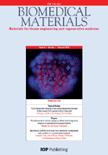
Biomedical Materials
Bridging Biology and Engineering for Medical Breakthroughs.Biomedical Materials, published by IOP Publishing Ltd, is a premier journal dedicated to the rapidly evolving field of biomedical engineering and materials science. With a robust impact factor showcasing its influence, this journal serves as a vital platform for disseminating pioneering research from 2006 to 2024. Covering an array of interdisciplinary topics—ranging from biomaterials to bioengineering and applied chemistry—the journal consistently ranks in the second quartile across multiple categories including Bioengineering (Q2), Biomaterials (Q2), and Biomedical Engineering (Q2) as of 2023. Researchers, professionals, and students alike benefit from its contributions, exploring innovative solutions at the intersection of biology and material science. Although not an Open Access journal, Biomedical Materials remains essential in advancing our understanding and facilitating discussions surrounding state-of-the-art materials that revolutionize medical applications and enhance patient care.

Discover Nano
Empowering Researchers to Transform NanotechnologyDiscover Nano is a pioneering journal published by SPRINGER, dedicated to the rapidly evolving field of nanoscience and nanotechnology. Established in 2023, this innovative platform provides an open-access forum for researchers, professionals, and students to share and disseminate cutting-edge findings in materials science and condensed matter physics. With its commitment to accessibility, Discover Nano encourages a broad spectrum of contributions, aiming to foster collaboration and stimulate discussion in this dynamic area of study. As a new entry into the academic community, the journal holds great potential for growth, aspiring to increase its visibility and impact in the materials science arena, where it currently ranks in the bottom quartile for both materials science and physics categories. Based in Germany and reaching a global audience, Discover Nano represents a significant opportunity for those looking to shape the future of nanotechnology through impactful research and interdisciplinary dialogue.

ACS Biomaterials Science & Engineering
Innovating the Intersection of Science and MedicineACS Biomaterials Science & Engineering, published by the American Chemical Society, serves as a premier platform for the latest advancements and research in the fields of biomaterials and biomedical engineering. With an impressive impact factor and a strong reputation reflected in its ranking—Q2 in Biomaterials and Q1 in Biomedical Engineering—the journal attracts a diverse and engaged readership. Since its inception in 2015, it has aimed to foster innovation by publishing high-quality research articles, reviews, and perspectives on the synthesis, characterization, and application of biomaterials. Researchers and professionals benefit from the journal's rigorous peer-review process and its focus on translational science, making it essential for those looking to stay at the forefront of biomaterials research. Located in Washington, DC, USA, the journal plays a pivotal role in connecting academic and industrial sectors, ultimately driving advancements that impact biomedicine and related fields.
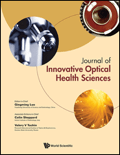
Journal of Innovative Optical Health Sciences
Empowering Research at the Forefront of Optical HealthWelcome to the Journal of Innovative Optical Health Sciences, an esteemed platform dedicated to the interdisciplinary exploration of optical technologies in health sciences. Published by World Scientific Publishing Co Pte Ltd, this open-access journal has been at the forefront of innovation since its inception in 2008, facilitating vital discussions and research advancements. With a notable impact factor and a commendable ranking in various scientific categories—including Q2 in Atomic and Molecular Physics, Q3 in Biomedical Engineering, and Q3 in Medicine (miscellaneous)—the journal serves as an essential resource for researchers, professionals, and students alike. Hailing from Singapore, we aim to bridge the gap between optical science and healthcare, promoting breakthroughs that enhance patient care and medical practices. Explore our diverse collection of studies and join a vibrant community committed to advancing knowledge in this cutting-edge field.

Biomaterials Research
Unveiling the potential of biomaterials for healthcare.Biomaterials Research, published by the American Association for the Advancement of Science, is a prominent open access journal established in 2014, dedicated to advancing the field of biomaterials. Based in the United Kingdom, this journal has swiftly become an essential platform for researchers and practitioners, offering groundbreaking insights in biomaterials, biomedical engineering, ceramics and composites, and miscellaneous medical fields. With its impressive Q1 ranking across multiple relevant categories in 2023 and its strong Scopus rankings, including a remarkable 90th percentile in the medicine category, Biomaterials Research showcases high-quality, peer-reviewed research designed to address both practical and theoretical challenges in biomaterials science. As an open access journal, it promotes wider dissemination and accessibility of research findings, crucial for fostering innovation and collaboration within the scientific community. Researchers, professionals, and students alike are encouraged to contribute, read, and engage with the latest developments in this dynamic field.
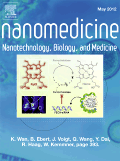
Nanomedicine-Nanotechnology Biology and Medicine
Innovating Healthcare: Where Nanotechnology Meets MedicineNanomedicine-Nanotechnology Biology and Medicine is a leading journal published by Elsevier, dedicated to the exploration of innovative applications of nanotechnology in the fields of biology and medicine. With an ISSN of 1549-9634 and an E-ISSN of 1549-9642, this esteemed journal provides a platform for high-quality research, comprehensively covering areas including bioengineering, biomedical engineering, pharmaceutical science, and nanoscience. Notably, it holds a significant position in various categories with a Q2 ranking in multiple disciplines and a prestigious Q1 ranking in Pharmaceutical Science, emphasizing its impact within the scientific community. By facilitating access to cutting-edge studies and advancements, Nanomedicine-Nanotechnology Biology and Medicine serves as an essential resource for researchers, professionals, and students alike, contributing significantly to the ongoing development of nanomedicine and its pivotal role in improving healthcare outcomes. The journal operates without open access; however, it remains committed to disseminating valuable knowledge to a global audience.

Materials Today Bio
Advancing the frontier of bioengineering and biomaterials.Materials Today Bio, published by Elsevier, is an esteemed open-access journal dedicated to advancing the fields of bioengineering, biomaterials, and biomedical engineering. Since its inception in 2019, this journal has quickly made a name for itself, currently ranked Q1 in multiple categories including Bioengineering, Biomaterials, and Biotechnology, reflecting its exceptional quality and relevance in the rapidly evolving landscape of bio-related sciences. With an impressive Scopus ranking positioning it in the top 25% of its categories, Materials Today Bio provides a vital platform for researchers and professionals to share cutting-edge discoveries and innovative applications that bridge the gap between materials science and biological studies. Accessible to a global audience, this journal not only fosters collaboration among the scientific community but also aims to highlight significant advancements in cell and molecular biology, making it an indispensable resource for students and seasoned experts alike. The journal's commitment to open access since 2019 underscores its dedication to disseminating knowledge widely, ensuring that crucial findings reach those who can benefit from them the most.
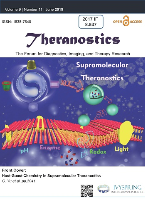
Theranostics
Innovative Insights for Enhanced Patient Care.Theranostics is a premier journal in the field of Medicine and Pharmacology, published by IVYSPRING INT PUBL. With its commitment to open access since 2011, it facilitates the widespread dissemination of innovative research, fostering collaboration and advancements in therapeutic diagnostics. The journal proudly holds a Q1 ranking in both Medicine (Miscellaneous) and Pharmacology, Toxicology and Pharmaceutics, as of 2023, showcasing its esteemed position within the scientific community. Recognized globally, it ranks in the top 1%, with Scopus rankings placing it as 4th out of 398 in Medicine and 1st out of 43 in Pharmacology. Theranostics serves as a crucial platform for researchers, professionals, and students to explore cutting-edge developments as it converges multidisciplinary approaches to enhance patient care and treatment efficacy. With a focus on bridging experimental research and clinical applications, the journal is instrumental in shaping future therapies and diagnostic strategies.
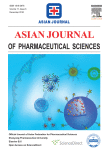
Asian Journal of Pharmaceutical Sciences
Connecting global minds through open-access pharmaceutical research.Asian Journal of Pharmaceutical Sciences is a prestigious open-access journal published by Shenyang Pharmaceutical University, dedicated to advancing research and developments in the field of pharmaceutical sciences. Since its inception in 2009, the journal has successfully converged a wealth of knowledge and innovation, demonstrating an impressive track record with its open access model adopted in 2013, ensuring global dissemination of crucial research findings. With an outstanding impact factor and consistently ranked in the Q1 category for both Pharmaceutical Science and Pharmacology in 2023, it ranks among the top journals in its field, as evidenced by its impressive Scopus rankings—4th out of 183 in Pharmaceutical Science and 10th out of 313 in Pharmacology, showcasing its high relevance and credibility (98th and 96th percentiles respectively). Researchers, professionals, and students can access a diverse array of articles that encompass groundbreaking studies, reviews, and reports, solidifying the journal's position as a vital resource for anyone engaged in pharmaceutical research. With its commitment to quality and accessibility, Asian Journal of Pharmaceutical Sciences plays an essential role in fostering innovation and collaboration within the global scientific community.

BME Frontiers
Innovating at the Intersection of Science and MedicineBME Frontiers, published by the American Association for the Advancement of Science, is an innovative open-access journal dedicated to the burgeoning field of Biomedical Engineering. Since its establishment in 2020, this journal has aimed to bridge the gap between cutting-edge research and practical application, promoting advancements in biomedical technologies, medical devices, and healthcare solutions. Boasting impressive rankings within Scopus—64th among 398 in Medicine (miscellaneous) and 81st among 303 in Biomedical Engineering—BME Frontiers stands out as a significant contributor to scholarly communication, offering rich insights for researchers, professionals, and students alike. With consistent publication projected through 2024, the journal serves as an essential platform for disseminating high-quality research that can drive innovation and inspire new approaches in the healthcare sector.